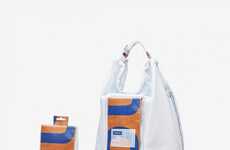
Accessories from Catfluff are Made With Vintage Army Surplus
Natasha Suter — April 15, 2010 — Eco
Taking the pop Military fashion trend to the next level, designer Catfluff reconstructed a line of messenger bags created out of authentic Euro Vintage army surplus materials.
The fabulous featured bag was upcycled from a vintage army Czech bread bag. These types of messenger style bags were issued to the soldiers during the cold war and used for their rations. Look for the 1968 date stamped on the inside. Catfluff styles them to accommodate the urban modern man with his gadgets and laptops.
This is a totally unique concept in bridging trends! Stitch by stitch, this American European-born designer and seamstress recycles textile scraps and potato sacks to create cutting edge purses, bags, market sacks and accessories.
The fabulous featured bag was upcycled from a vintage army Czech bread bag. These types of messenger style bags were issued to the soldiers during the cold war and used for their rations. Look for the 1968 date stamped on the inside. Catfluff styles them to accommodate the urban modern man with his gadgets and laptops.
This is a totally unique concept in bridging trends! Stitch by stitch, this American European-born designer and seamstress recycles textile scraps and potato sacks to create cutting edge purses, bags, market sacks and accessories.
Trend Themes
1. Upcycling Fashion - The trend of upcycling vintage materials to create new fashion pieces for modern consumers presents opportunities for disruptive innovation in sustainable fashion design and production.
2. Military-inspired Accessories - The trend of using military-inspired design elements in accessories and fashion presents opportunities for disruptive innovation in fashion design and product development for urban consumers.
3. Retro-modern Styling - The trend of combining vintage materials and styling with modern functionality presents opportunities for disruptive innovation in fashion design and product development for consumers who value both style and practicality.
Industry Implications
1. Fashion - The fashion industry could disruptively innovate by incorporating upcycling practices into sustainable fashion design and production and by incorporating military-inspired design elements into accessories and apparel.
2. Textile Manufacturing - The textile manufacturing industry could disruptively innovate by exploring ways to produce sustainable textile materials from recycled or upcycled sources, as well as develop new methods to incorporate vintage materials into modern designs.
3. Retail - The retail industry could disruptively innovate by capitalizing on the retro-modern styling trend and catering to consumers who are looking for functional yet stylish accessories and apparel made from sustainable and recycled materials.
5.1
Score
Popularity
Activity
Freshness























